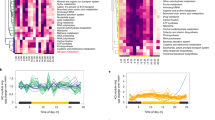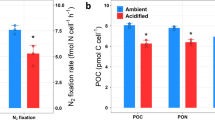Abstract
The factors that control the growth and nitrogen fixation rates of marine diazotrophs such as Trichodesmium have been intensively studied because of the role that these processes have in the global cycling of carbon and nitrogen, and in the sequestration of carbon to the deep sea. Because the phosphate concentrations of many ocean gyres are low1, the bioavailability of the larger, chemically heterogeneous pool of dissolved organic phosphorus could markedly influence Trichodesmium physiology. Here we describe the induction, by phosphorus stress, of genes from the Trichodesmium erythraeum IMS101 genome that are predicted to encode proteins associated with the high-affinity transport and hydrolysis of phosphonate compounds by a carbon–phosphorus lyase pathway. We show the importance of these genes through expression analyses with T. erythraeum from the Sargasso Sea. Phosphonates are known to be present in oligotrophic marine systems, but have not previously been considered to be bioavailable to marine diazotrophs. The apparent absence of genes encoding a carbon–phosphorus lyase pathway in the other marine cyanobacterial genomes suggests that, relative to other phytoplankton, Trichodesmium is uniquely adapted for scavenging phosphorus from organic sources. This adaptation may help to explain the prevalence of Trichodesmium in low phosphate, oligotrophic systems.
This is a preview of subscription content, access via your institution
Access options
Subscribe to this journal
Receive 51 print issues and online access
$199.00 per year
only $3.90 per issue
Buy this article
- Purchase on Springer Link
- Instant access to full article PDF
Prices may be subject to local taxes which are calculated during checkout


Similar content being viewed by others
References
Wu, J., Sunda, W. G., Boyle, E. A. & Karl, D. M. Phosphate depletion in the Western North Atlantic Ocean. Science 289, 759–762 (2000)
Field, C. B., Beherenfeld, M. J., Randerson, J. T. & Falkowski, P. G. Primary production of the biosphere: integrating terrestrial and oceanic components. Science 281, 237–240 (1998)
Montoya, J. P. et al. High rates of N2 fixation by unicellular diazotrophs in the oligotrophic Pacific Ocean. Nature 430, 1027–1031 (2004)
Capone, D. G., Zehr, J. P., Paerl, H. W., Bergman, B. & Carpenter, E. J. Trichodesmium, a globally significant marine cyanobacterium. Science 276, 1221–1229 (1997)
Carpenter, E. J. & Romans, K. M. Major role of the cyanobacterium Trichodesmium in nutrient cycling in the North Atlantic Ocean. Science 254, 1356–1358 (1991)
Sañudo-Wilhelmy, S. A. et al. Phosphorus limitation of nitrogen fixation by Trichodesmium in the central Atlantic Ocean. Nature 411, 66–69 (2001)
Sañudo-Wilhelmy, S. A. et al. The impact of surface-adsorbed phosphorus on phytoplankton Redfield stoichiometry. Nature 432, 897–901 (2004)
Ammerman, J. W., Hood, R. R., Case, D. A. & Cotner, J. B. Phosphorus deficiency in the Atlantic: an emerging paradigm in oceanography. Eos 84, 165–170 (2003)
Clark, L. L., Ingall, E. D. & Benner, R. Marine phosphorus is selectively remineralized. Nature 393, 426 (1998)
Kolowith, L. C., Ingall, E. D. & Benner, R. Composition and cycling of marine organic phosphorus. Limnol. Oceanogr. 46, 309–320 (2001)
Stihl, A., Sommer, U. & Post, A. F. Alkaline phosphatase activities among populations of the colony-forming, diazotrophic cyanobacterium Trichodesmium spp. (Cyanobacteria) in the Red Sea. J. Phycol. 62, 310–317 (2001)
Dyhrman, S. T., Webb, E., Anderson, D. M., Moffett, J. & Waterbury, J. Cell specific detection of phosphorus stress in Trichodesmium from the Western North Atlantic. Limnol. Oceanogr. 47, 1823–1836 (2002)
Paytan, A., Cade-Menun, B. J., McLaughlin, K. & Faul, K. L. Selective phosphorus regeneration of sinking marine particles: evidence from 31P-NMR. Mar. Chem. 82, 55–70 (2003)
Palenik, B. et al. The genome of a motile marine Synechococcus. Nature 424, 1037–1042 (2003)
Moore, L. R., Ostrowski, M., Scanlan, D. J., Feren, K. & Sweetsir, T. Ecotypic variation in phosphorus-acquisition mechanisms within marine picocyanobacteria. Aquat. Microb. Ecol. 39, 257–269 (2005)
Wanner, B. L. Molecular genetics of carbon–phosphorus bond cleavage in bacteria. Biodegradation 5, 175–184 (1994)
Kononova, S. V. & Nesmeyanova, M. A. Phosphonates and their degradation by microorganisms. Biochemistry (Moscow) 67, 220–233 (2002)
White, A. W. & Metcalf, W. M. Two C–P lyase operons in Pseudomonas stutzeri and their roles in the oxidation of phosphonates, phosphite and hypophosphite. J. Bact. 186, 4730–4739 (2004)
Lundgren, P., Janon, S., Jonasson, S., Singer, A. & Bergman, B. Unveiling of novel radiations within Trichodesmium cluster by hetR gene sequence analysis. Appl. Environ. Microbiol. 71, 190–196 (2005)
Karl, D. M. & Björkman, K. M. in Biogeochemistry of Marine Dissolved Organic Matter (eds Hansell, D. & Carlson, C.) 249–366 (Elsevier Science, Boston, USA, 2002)
Webb, E. A., Moffett, J. W. & Waterbury, J. B. Iron stress in open-ocean cyanobacteria (Synechococcus, Trichodesmium, and Crocosphaera spp.): identification of the IdiA protein. Appl. Environ. Microbiol. 67, 5444–5452 (2001)
Karl, D. M. & Tien, G. MAGIC: A sensitive and precise method for measuring dissolved phosphorus in aquatic environments. Limnol. Oceanogr. 37, 105–116 (1992)
Armstrong, F. A. J., Williams, P. M. & Strickland, J. D. H. Photo-oxidation of organic matter in sea water by ultra-violet radiation, analytical and other applications. Nature 211, 481–483 (1966)
Koroleff, F. in Methods of Seawater Analysis (eds Grashoff, K., Ehrhardt, M. & Kremling, K.) 125–138 (Verlag Chemie, Weinheim, Denmark, 1983)
Acknowledgements
We thank the captain and crew of the RV Oceanus, I. Ehrenreich and R. Wisniewski for assistance; and V. Edgecomb and F. Valois for suggestions on the manuscript. The T. erythraeum IMS101 genome was produced by the US Department of Energy Joint Genome Institute (http://www.jgi.doe.gov/). This work was supported by the National Science Foundation Biological Oceanography Program, the Woods Hole Oceanographic Institution and the Princeton Center for BioInorganic Chemistry. Author Contributions S.T.D. and E.A.W. designed the research and wrote the paper; S.T.D., J.W.M and E.A.W performed the field work; P.D.C, S.T.D, S.T.H., E.D.O., J.B.W. and E.A.W. performed the laboratory work; and E.A.W. performed the genome searches and phylogenetic analyses.
Author information
Authors and Affiliations
Corresponding author
Ethics declarations
Competing interests
The sequences of phnJ and phnD from the different Trichodesmium species have been deposited in GenBank with accession numbers DQ176437–DQ176442. Reprints and permissions information is available at npg.nature.com/reprintsandpermissions. The authors declare no competing financial interests.
Supplementary information
Supplementary Figure 1
This is a sequence alignment of phnJ from species of the genus Trichodesmium. (DOC 290 kb)
Supplementary Figure 2
This is a sequence alignment of phnD from species of the genus Trichodesmium. (DOC 136 kb)
Supplementary Table 1
This table lists the % identity between the Trichodemsium Phn orthologs and several different microbes. (DOC 26 kb)
Supplementary Table 2
This table lists analyses and estimates of dissolved inorganic phosphate, and dissolved organic phosphorus at the three field stations in the western North Atlantic along with other field parameters. (DOC 20 kb)
Supplementary Data
This contains the full amino acid sequences. (TXT 9 kb)
Rights and permissions
About this article
Cite this article
Dyhrman, S., Chappell, P., Haley, S. et al. Phosphonate utilization by the globally important marine diazotroph Trichodesmium. Nature 439, 68–71 (2006). https://doi.org/10.1038/nature04203
Received:
Accepted:
Issue Date:
DOI: https://doi.org/10.1038/nature04203
This article is cited by
-
The facilitating role of phycospheric heterotrophic bacteria in cyanobacterial phosphonate availability and Microcystis bloom maintenance
Microbiome (2023)
-
Methylphosphonate-driven methane formation and its link to primary production in the oligotrophic North Atlantic
Nature Communications (2023)
-
Phosphorus availability on the early Earth and the impacts of life
Nature Geoscience (2023)
-
Selection of an Extraction Method Suitable for Estimating Potentially Available Phosphorus Under the Organic Production System of New Alluvial Zone of the Lower Gangetic Plain of India
Journal of Soil Science and Plant Nutrition (2023)
-
Dissolved organic phosphorus concentrations in the surface ocean controlled by both phosphate and iron stress
Nature Geoscience (2022)
Comments
By submitting a comment you agree to abide by our Terms and Community Guidelines. If you find something abusive or that does not comply with our terms or guidelines please flag it as inappropriate.



